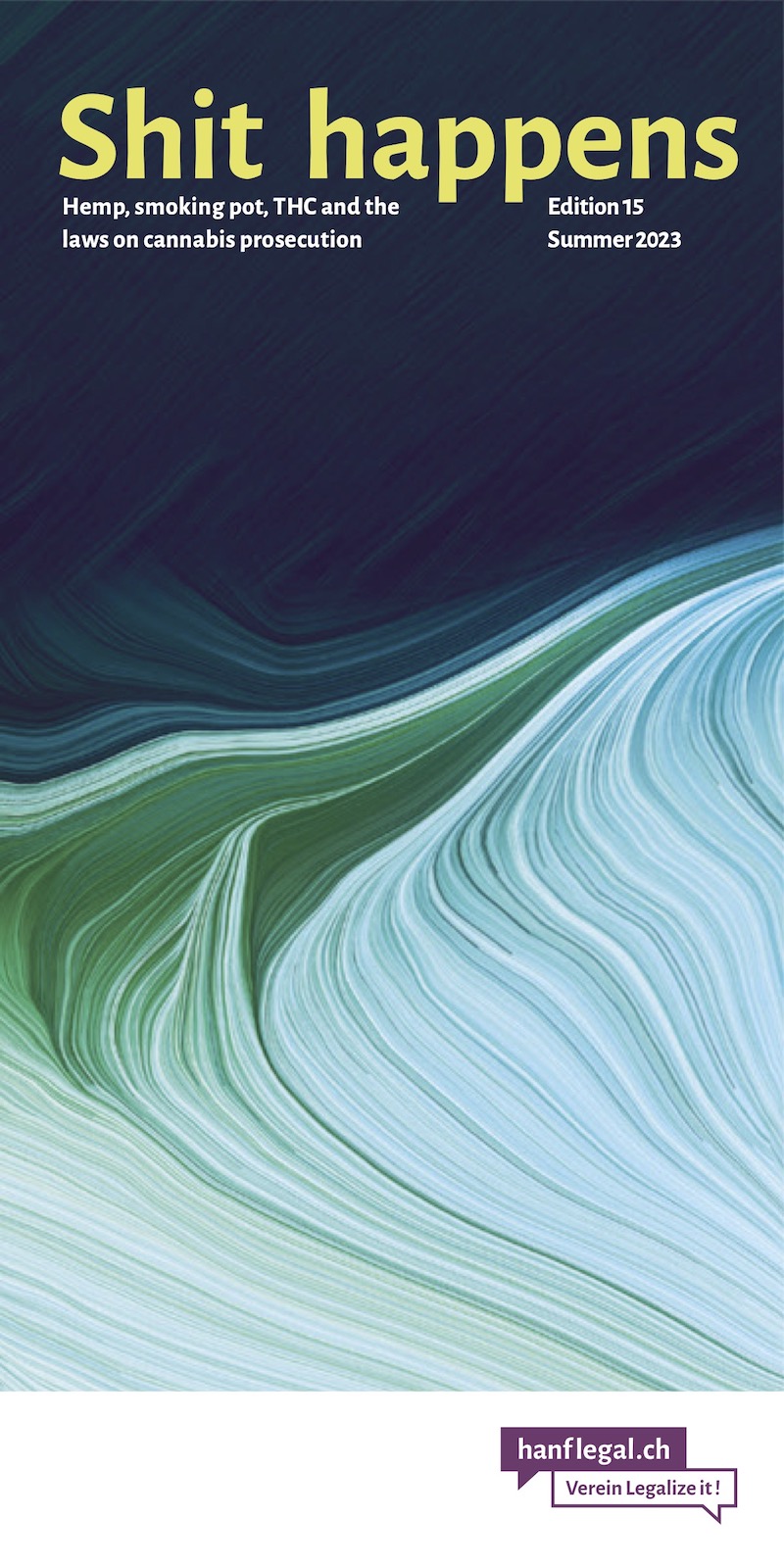- THC & Law:
Further figures from the health study
The Swiss Health Survey contains a lot of data on the smoking behavior of the population in Switzerland. This time we are interested in how various percentages have changed over the last ten years.
In the first article (see Legalize it! 28) on the health survey of the Swiss Federal Statistical Office, we presented the frequencies for current consumption according to the different age groups and compared them with the results of another study. These data were for 2002, and in this second article we would like to document the change over the past decade. It should be noted that the data for all three study years are only available for 15-39 year olds.
Lifetime prevalence over time, between genders, German-speaking and French-speaking Switzerland, urban and rural areas, educational levels
The first interesting question is whether someone has ever smoked pot in their lifetime, or whether no THC molecules have passed through their brain at all. This question about lifetime prevalence says nothing about current use, but only whether someone has had experience with cannabis at some point in their life or not. So how has the experience with cannabis developed over time? The following table shows the values for the three years of the health study:
| 1992 | 1997 | 2002 | |
|---|---|---|---|
| “ever” | 16.3% | 26.7% | 27.7% |
In the last five years, the percentage of those who have smoked pot at least once has remained fairly stable at just over 25%. About a quarter of the 15-39 year olds try cannabis use at some point in their lives. The vast majority of the population still has no experience with smoking pot (72.3% in 2002).
The following table shows the lifetime prevalence of cannabis use by gender:
| 1992 | 1997 | 2002 | |
|---|---|---|---|
| Men | 21.5% | 33.4% | 34.2% |
| Women | 11.1% | 19.9% | 21.1% |
Every third man and every fifth woman has had some experience with smoking pot. In the last five years, the values are practically constant - a large increase was only recorded between 1992 and 1997.
Then to the ratio German- to French-speaking Switzerland. The proportions here are:
| 1992 | 1997 | 2002 | |
|---|---|---|---|
| German-CH | 16.3% | 27.2% | 27.2% |
| Romandie | 17.3% | 26.9% | 31.9% |
The Welsh are more experienced in smoking pot than the Alemannic. However, the general trend is very similar to the total figures. Now let's look at the values for urban and rural areas:
| 1992 | 1997 | 2002 | |
|---|---|---|---|
| City | 17.7% | 29.7% | 28.7% |
| Country | 13.0% | 20.5% | 25.4% |
So urbanites are better acquainted with smoking pot, though the differences have largely leveled out. And then we take a look at the different levels of education:
| 1992 | 1997 | 2002 | |
|---|---|---|---|
| deep | 14.0% | 25.5% | 23.8% |
| medium | 16.6% | 27.5% | 29.0% |
| high | 19.7% | 29.4% | 33.4% |
We see that among the most educated, one in three had experience with THC, while among those who attended compulsory school, it was just under one in four. Drug-trying behavior thus seems to increase with increasing education.
Current use over time, between age groups, German and French-speaking Switzerland, urban and rural areas, educational levels. However, even if a quarter have had experience with smoking pot, this does not mean that these people are still smoking pot today. When the survey asked about current use, the following proportions of 15-39 year olds said they still smoke pot:
| 1992 | 1997 | 2002 | |
|---|---|---|---|
| “current” | 4.4% | 7.0% | 7.5% |
Here, too, we see that the big jump happened in the first five years - since then, the growth has been rather small. And we also see that the vast majority (around three quarters, from 27.7% to 7.5%) of those trying no longer have a current use, i.e. have already stopped smoking pot again. The above figures also mean that 92.5% of the population no longer have (or have never had) a current use of cannabis. So we stoners are really a small minority. Furthermore, you have to keep in mind that “current use” means use in 2002: already smoked once in 2002 - and you are already in the category “current smoker”. So the 7.5% includes occasional and hardcore smokers. Unfortunately, the study makes no distinction between different groups of people who smoke pot. We all know, of course, that there are massive differences between someone who takes a drag on a joint once every three weeks and someone who is predominantly busy rolling and smoking their 25 joints a day. But both (and all possible intermediate levels) are subsumed into this one category of current stoners.
In the different age groups, smoking pot is also represented to different degrees (see also the graphs in Legalize it! 28, page 32/33). Here we want to look at the development over time:
| 1992 | 2002 | Increase | |
|---|---|---|---|
| 15-24 years old | 7.1% | 12.0% | + 69% |
| 25-34-year-old | 3.8% | 6.3% | + 66% |
| 35-39 years old | 1.3% | 3.4% | +162% |
| Total | 4.4% | 7.5% | + 70% |
Unfortunately, there are no such figures for the over-40s. But even so, we can see that the increase in current users is very large, especially in the 40-plus category. Slowly, we stoners have become firmly anchored among the elderly. This trend is likely to continue in the future until a certain ceiling is reached. With this spreading of active smoking also into older (and mostly better earning and better respected) age groups, our power (understood as the ability to influence this society) naturally increases. This could make one optimistic about the implementation of legalization in the long run.
Now a comparison between French-speaking Switzerland and German-speaking Switzerland. Again, the current smokers in the three age groups:
| 1992 | 1997 | 2002 | |
|---|---|---|---|
| German-CH | 4.5% | 7.5% | 7.4% |
| Romandie | 4.3% | 6.0% | 8.8% |
The number of people smoking pot in the French-speaking part of Switzerland has increased and has now surpassed the number of people smoking pot in the German-speaking part of Switzerland. And this despite (or because of?) the fact that repression against smoking pot is more frequent in French-speaking Switzerland than in the German-speaking part of our country. We also see that smoking pot in French-speaking Switzerland has increased massively in the last five years from 6 to 8.8 percent, while in German-speaking Switzerland a kind of ceiling has already been reached, or the proportion has even declined slightly for the first time (from 7.5 to 7.4 percent).
Do people in rural areas smoke pot more or less frequently than people in urban areas? Our next table shows the development of current consumption over the last ten years:
| 1992 | 1997 | 2002 | |
|---|---|---|---|
| City | 5.2% | 7.6% | 7.6% |
| Country | 2.5% | 5.9% | 7.3% |
We see that the differences (more than twice as many current pot smokers in 1992 in the city than in the countryside, 5.2 to 2.5 percent) have practically leveled out in 2002 (7.6 and 7.3% in 2002). After this catch-up (almost tripling the rate in ten years, from 2.5 to 7.3%), an upper ceiling will have been reached here, as it has been for five years in the city. The value for rural areas could now also stabilize at around 7.5%.
Do the less educated smoke pot more or less than the better educated? The table shows the values for three cohorts:
| 1992 | 1997 | 2002 | |
|---|---|---|---|
| deep | 5.2% | 8.6% | 8.7% |
| medium | 4.3% | 7.3% | 7.7% |
| high | 3.4% | 5.2% | 4.9% |
Thus, in the lower educational levels, 75% more respondents smoke pot than, for example, among people with a university degree (8.7 to 4.9%). Nevertheless, every twentieth highly educated person currently smokes pot. These results are now exactly the opposite of the lifetime prevalence (see at the beginning of our article): There, more than one third of the highly educated were THC-experienced, while among the less educated it was only one in four. Thus, the less educated try cannabis less often than the highly educated, but stay with it more often.
Support our work with a donation:
Bank transfer
Account number (IBAN):
CH02 0900 0000 8709 1354 3
Full account details
Or scan this QR code with your eBanking App (ZKB, Revolut, Postfinance, …):

Or open/share the QR code as PDF file with your eBanking App.
Credit card
Donate via credit card
Verein Legalize it!
Quellenstrasse 25
8005 Zürich
Threema ID 7NH65RBY
Don’t miss anything! Follow us on social media:

